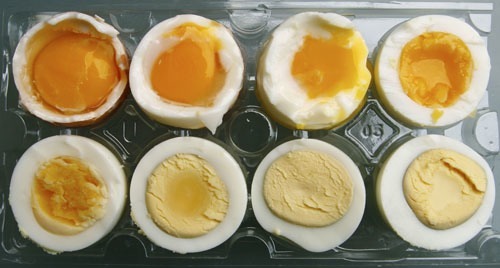I love eggs (of course, they go well with bacon). I thought I had the boiled egg recipe down cold, but I ran across this article that really digs into the details of how to make a perfect boiled egg. I love it when people really breakdown the science of what's going on and then to the experimentation to back it up. Worth a read.
http://www.seriouseats.com/2009/10/the-food-lab-science-of-how-to-cook-perfect-boiled-eggs.html
Some snippets:

The Temperature Timeline of Boiling an Egg
Now, here's what happens as an egg white cooks:
- From 30 -140 degrees: As it gets hot, its proteins, which resemble coiled up balls of yarn, slowly start to uncoil.
- At 140 degrees: Some of these uncoiled proteins—called ovotransferrin—begin to bond with each other, creating a matrix, and turning the egg white milky and jelly-like (like the innermost layers of egg white in the 3-minute egg above).
- At 155 degrees: The ovotransferrin has formed and opaque solid, though it is still quite soft and moist (see the white of the 5-minute egg).
- At 180 degrees: The main protein in egg whites—ovalbumen—will cross-link and solidify, giving you a totally firm egg white (see the whites of the 7 and 9 minute eggs). This is very similar to the gunk that seeps out of the surface of overcooked salmon.
- 180 degrees-plus: The hotter you get the egg, the tighter these proteins bond, and the firmer, drier, and rubbier the egg white becomes (the 11-15 minute eggs). Hydrogen Sulfide, or "rotten-egg" aromas, begin to develop. Ick.
Egg yolks, on the other hand, follow a different set of temperatures:
- At 145 degrees: They begin to thicken and set up.
- At 158 degrees: They become totally firm, but are still bright orange and shiny.
- At 170 degrees: They become pale yellow and start to turn crumbly.
- 170 degrees-plus: They dry out and turn chalky. The sulfur in the whites rapidly reacts with the iron in the yolks, creating ferrous sulfide, and tinging the yolks.
The five degree temperature difference between when the egg white and the egg yolks firm is what allows chefs at fancy-pants restaurants to serve those "slow-cooked" eggs. They simply place the egg in a 140 degree water bath, wait about 45 minutes (by which point the egg has reached 140 degrees all the way from edge to center), then carefully crack them. The results is a white that is soft and translucent but holds it's shape, and a yolk that is still completely liquid. Beautiful.
So far so good? Is this all going over easy? Now with all this background information dealt with, we can move on to something a little more eggs-citing: perfecting the boil.

Marcia Reply
I'm going to have to try that 45-minute egg. Thanks for passing it on!